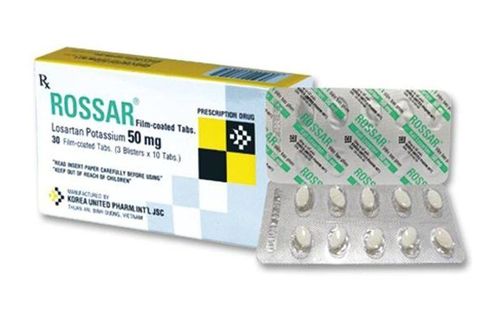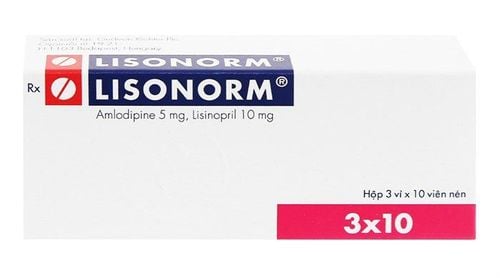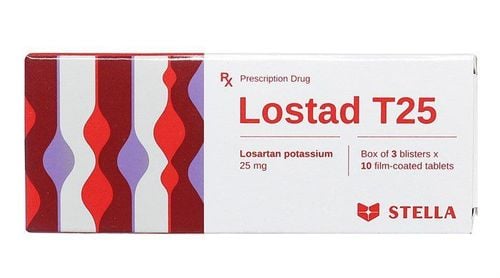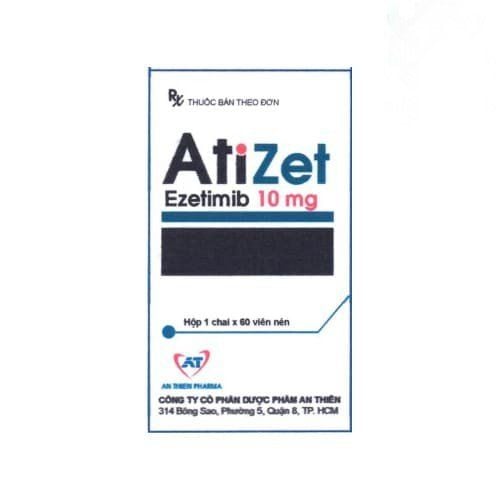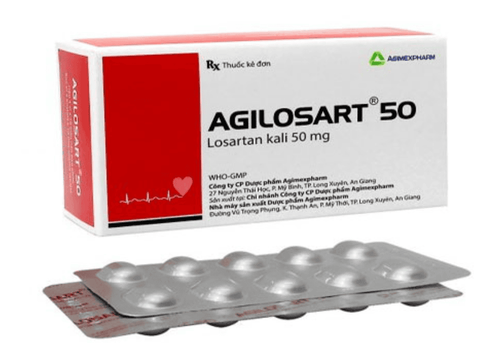This is an automatically translated article.
Adostan belongs to the group of cardiovascular drugs, effective in the treatment of mild to moderate hypertension. So what exactly does Adostan do and what cases is it indicated for?1. What is Adostan?
The drug Adostan has the active ingredient Losartan Potassium 50mg and other excipients just enough for 1 tablet. The drug is prepared for human consumption in the form of film-coated tablets and packaged in a box of 10 blisters, each blister contains 10 tablets.2. Uses of Adostan
2.1. Dosage - indications
Adostan is used to treat:Hypertension. Support to reduce the risk of cardiovascular morbidity and mortality for people with hypertension with left ventricular hypertrophy, stroke, myocardial infarction. Helps protect kidneys for people with type 2 diabetes who have proteinuria.
2.2. Contraindications
Cases of contraindications to the use of Adostan:People who are allergic or hypersensitive to the active ingredient Losartan contained in the drug. People who are pregnant and breastfeeding. Children under 18 years old. Note: The cases of contraindications should be understood as absolute contraindications, ie not for any reason that the above cases are flexible to use the drug.
3. Usage and dosage of Adostan
How to use: Adostan is prepared in the form of tablets that should be taken orally. It is recommended to use it with a sufficient amount of filtered water, avoid using it with other liquids such as milk, soft drinks, wine, beer. When taking, the patient should not break the tablet, break it in half, to avoid affecting the effect of the drug. Users can take the drug alone or with food or other high blood pressure medications.Dosage:
Used to treat hypertension: Initial dose and maintenance dose: 50mg/time/day. The maximum effect in the treatment of hypertension is achieved from 3 to 6 weeks. In some cases, it is possible to increase the dose up to 100mg to have better effect. In patients with intravascular volume depletion, the starting dose should be reduced to 25 mg once daily. For the elderly, people with kidney failure, people on dialysis: No need to adjust the dose. For people with a history of liver failure: Consider reducing the dose to a lower than normal. Used to assist in reducing the risk of cardiovascular disease and death in hypertensive patients with left ventricular hypertrophy: Initial dose: 50 mg/day/time. May decrease or increase to 100 mg/time/day, depending on the individual patient's BP response. Used to support kidney protection for people with type 2 diabetes with proteinuria: Usual dose: 50mg/time/day The dose may be increased to 100mg/time/day, depending on the blood response. pressure of each patient. Can be used in combination with other drugs such as: diuretics, calcium channel blockers, alpha or beta, other common hypoglycemic agents. Note: The effectiveness of the drug for each person is different, depending on the severity of the disease and the body condition of each person. Therefore, users need to use the drug exactly as directed by the doctor, absolutely do not increase or decrease the dose of the drug on their own.
In case of missed dose: User should continue to take the next dose at the prescribed time, do not use double the number of doses to make up for the missed dose.
In case of overdose: If an overdose is detected and dangerous symptoms appear, the user should immediately call 911 or go to the nearest medical facility for support measures. timely. When going, family members should bring prescriptions, medical records and drugs that the patient is using to make the process of verifying the cause faster and avoid causing danger to the body.
4. Side effects of the drug Adostan
In the process of using Adostan, in addition to the main use that the drug brings, users may also experience unwanted side effects as follows:Tachycardia, facial edema, facial redness, hypotension, chest pain , sinus bradycardia. Causes insomnia, sleep disturbance, anxiety, dizziness, migraine, confusion. May cause increased or decreased blood K, Gout. Occurrence of symptoms of diarrhea, loss of appetite, indigestion, vomiting, flatulence, constipation, loss of taste, intestinal spasms, gastritis. Causes leukopenia, thrombocytopenia, anemia. Causes leg pain, back pain, muscle pain, muscle weakness, fibromyalgia, tremor, joint edema. Causes urinary tract infections, slightly increased creatinine / urea. Causes bronchitis, cough, sinusitis, rhinitis, throat discomfort, airway congestion, nasal congestion. Causes hair loss, dry skin, erythema, dermatitis, itching, rash, photosensitivity, appearance of bruises on the skin. Renal failure, interstitial nephritis, polyuria, nocturia, decreased libido, impotence. Visual impairment, conjunctivitis, blurred vision, burning and pain in the eyes. Or sweating, tinnitus. Note: If the user experiences the above symptoms, it is necessary to immediately contact the treating doctor for diagnosis and timely application of treatment methods.
5. Adostan drug interactions
Some drug interactions of Adostan should be noted:Narcotic sleeping pills, Rifampin , Barbiturates. K supplements, K salt substitutes, K-sparing diuretics. Alcohols, muscle relaxants. Medicines for gout, anticoagulants, anesthetics, vitamin D. Note: Before using the drug, the patient needs to share with the doctor, pharmacist about the drugs or functional foods that he is or intends to use, to get advice and give the dosage combination. safest and most effective.




